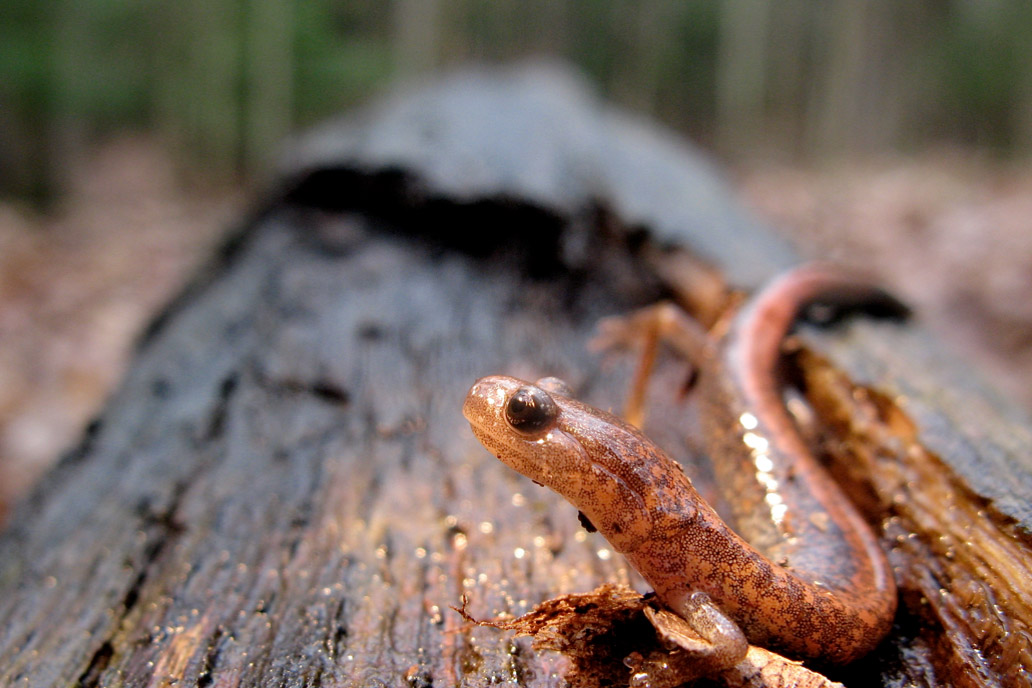Returning robins are one of the time-honored hallmarks of spring. But if you’re looking for something a little less obvious, follow commentator Chuck Staresinic’s lead and head out to a forgotten little stretch of land near Pittsburgh known as Salamander Park. There, warm rains bring a chance to observe salamanders carrying out one of the silent, sexy rituals of spring. (NOTE: This essay was originally published on March 21, 2007.)
Salamander Park is an enormous leaf-strewn puddle in the forest. It looks like a mistake, like a half-finished excavation, abandoned and flooded. Shrubs are rooted in the muck. They spread through the water and reach skyward like mangroves. A skinny sycamore leans in the middle like the derelict mast of a sunken sailboat. The shallow water beneath is perfectly still. The place is rank with mud and rot and life.
I first came here a few years ago on a stormy night in early spring. Rain tumbled through the bare branches and pattered on the forest floor. I shined my flashlight in the shallows, and the improbable creature came into focus: A stout, black salamander—longer than my hand—sporting bright yellow spots. More salamanders came until there were dozens swirling silently about in a lumbering aquatic ballet.
LISTEN: “The Secret Life of Salamanders”
Their sperm packets appeared like little white mushrooms upon the leaves and sticks around them. A female picks up a few, and about a week later, she lays clumps of fertilized eggs that cling to submerged vegetation. The adults return to the forest and will probably not be seen above ground for another year. The embryos develop over several weeks in this vernal pool, which is swollen with rain and snow melt. When they hatch, they are something like tadpoles—little aquatic predators with frilly external gills. The pool may dry up in the heat of summer, but before that happens, the juvenile salamanders grow, lose their gills and take shelter in the forest.
The salamanders are bound to this fickle resource. The almost never breed in larger, more permanent bodies of water, where fish and turtles would prey on the eggs. I’ve always found it surprising that this soggy patch of suburban wood has endured so close to the city, nestled in the fork of two busy roads, where the rush of cars rises and falls like the wind. So many similar wetlands have been lost. Finding nowhere to breed, the salamanders dwindle for a few years, then disappear.
I learned just weeks ago that this land was going to be developed in the 1960s, until a high school biology teacher named Beulah Frey became involved. Beulah Frey was born in 1921. As a beginning teacher, she mostly taught math, until the principal noticed the passion she brought to biology. She took her students to study life at this pond, which she had visited as a girl. Then her students learned there were plans to fill the pond with earth and develop the property. “People have their own ideas of what beauty is and what is needed in the world,” she told me. Some thought it was an eyesore. Some were afraid of the seemingly stagnant water and mosquitoes. Other coveted the land for homes.

Marbled salamander larvae swim in a forest pool in the Pennsylvania woods. Unlike most amphibians, marbled salamanders breed in the fall instead of spring. Photo: Richard Bonnet via Flickr
Beulah Frey says she wouldn’t have had the courage to speak at the township meeting if not for her students. But they felt very strongly that the pond should remain, and she felt she had to speak for them. She doesn’t even remember what she said. Just that she stood up, and the words flowed out of her. After the meeting, a few of the men told her that she had just about made them cry. As a direct result, the Borough of Fox Chapel voted to create Salamander Park.
A few days ago, I went back there hoping to see salamander eggs for the first time. It was sunny and warm, and the forest was awakening fast. Robins rustled the leaf litter all around. Fat wasps droned overhead, and the short liquid trill of a woodpecker rolled repeatedly down the hill behind me. It was several minutes before I saw clumps of salamander eggs in deeper water, wrapped around sticks like large ghostly marshmallows. They were flecked throughout with bits of darker matter, but it was too far to see details.
As I rose to leave, I spotted a tiny raft of stuff at the water’s edge. I dipped my hand beneath it and lifted. The water fell away and a clear mass of jelly pooled across the width of my palm and outstretched fingers. It threatened to spill from the edges, but somehow held together, jiggling. It was run through with streaks of bright green algae and dark slivers of amphibian life: Embryonic salamanders, evenly spaced, curled into tiny parentheses. I held them close to my face as one, then another, twitched and flipped—fully alive, eager to spring forth upon the larger world—but for this moment, resting wholly in the palm of my hand.



